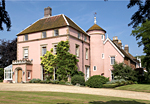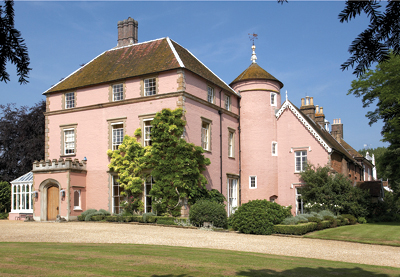Two important Bedfordshire manor houses for sale
Two extraordinary manor houses that bear witness to hundreds of years of English history have come onto the market


Historically, Bedfordshire has always been a quiet county that, despite its proximity to London, has seen few battles or revolts. Neither the Norman Conquest nor the Wars of the Roses, nor even the Civil War, led to any major confrontation on home soil. Yet the sale of two important Bedfordshire manor houses, built within a few miles of each other in the picturesque southern corner of the county, underlines the extent to which leading local landowners were involved with the major, often scandalous, events of their day.
The history of Toddington Manor at Toddington, six miles west of Woburn-currently for sale through Strutt & Parker (020-7629 7282) at a guide price of £8 million-dates from the early 16th century, when Kentish nobleman Sir Thomas Cheney married Anne, heiress daughter of Sir John Broughton of Toddington. A highly regarded courtier and politician under Henry VII and Henry VIII, Sir Thomas amassed vast estates in Bedfordshire and Kent.

On his death in 1559, Sir Thomas's estates passed to his profligate son, Henry, who immediately set about building the massive new manor house at Toddington, where he was knighted by Elizabeth I in 1563. The imposing mansion, based on three courts, was three storeys high with four-storey round towers at each corner, and a 210ft-long frontage from north to south.
Lord Cheney had no heir, and, when he died in 1587, the estates passed to his widow Jane, daughter of the 1st Baron Wentworth of Nettlestead, who entertained James I at Toddington in 1608. When she died in 1614, the estates passed to her greatnephew Thomas, 4th Baron Wentworth, later Earl of Cleveland, who, together with his son, ran up enormous debts, which led to his property being sequestered under the Commonwealth in 1650.
On Cleveland's death, his granddaughter Henrietta Maria, Baroness Wentworth, inherited Toddington. She began an affair with Charles II's illegitimate son, the Duke of Monmouth, who hid at Toddington in 1683 after the discovery of the Rye House plot, in which he was heavily implicated. Lady Wentworth followed the duke into exile in Brussels, but eventually returned to Toddington, where she died in 1686, a year after the duke's execution following the Battle of Sedgemoor.
By 1745, Toddington Manor had fallen into serious disrepair, and was largely dismantled by William Wentworth, Earl of Strafford, except for the north-east corner containing the kitchens and one of the corner turrets. In 1806, his descendants sold the estate to the Cooper family, who remodelled and extended the remaining part of the house to create the building as it stands today, turning the former great Tudor kitchen with its two huge fireplaces into the present dining room.
The last of the Coopers left Toddington in 1905, after which it was sold several times before being bought by a research farm in 1948. Toddington's present owners, Sir Neville and Lady Georgina Bowman-Shaw, bought the manor from the research institution in 1979. Lady Bowman-Shaw recalls the sequence of events with wry humour: ‘When we married in 1962, our first home was Toddington Park, the Regency house on the hill above the manor. We had 70 acres, a large garden, and we moved in with the builders.
Sign up for the Country Life Newsletter
Exquisite houses, the beauty of Nature, and how to get the most from your life, straight to your inbox.
Seventeen years, four children and 600 acres later, we bought the manor, plus a further 500 acres. The house had been only partly lived in for 30 years, and the garden was a jungle. For two years, we dug, burnt, bulldozed, bored and exhausted our friends, and spent energy I never knew we had encouraging the army of builders and making gallons of tea. When the house was habitable, we started on the farmhouses and buildings.'
In 1994, the main part of the farm was sold off, leaving Toddington Manor, which is listed Grade II, surrounded by 178 rolling acres of farmland, pasture and woodland, including a splendid private cricket pitch, four ponds, a lake and its famous gardens. The 14,279sq ft house is grand but friendly. It has fine reception rooms, including a drawing room, formal and family dining rooms, a library, a billiard room and a conservatory. Upstairs, the south wing houses the master suite, which has a bedroom, two dressing rooms, a bathroom, a shower room, a sauna and views over the cricket pitch and formal gardens; there are three further bedrooms on the floor above. The main guest suite is in the north wing, with four more en-suite bedrooms in the east wing.
Secondary buildings include a three-bedroom gate lodge and a Grade II-listed stable block with six stables, six garages, offices and two flats. Sir Neville is a keen sportsman, and, for more than 30 years, Toddington Manor has had a noted pheasant and partridge shoot, with additional shooting rights over 800 neighbouring acres of land.
A few miles west as the crow flies, Grade II*-listed Harlington Manor at Harlington, near Flitwick, is one of Bedfordshire's oldest manor houses. Originally built in 1012, it was listed in the Domesday Book as being two cottages, before being gentrified in the 14th century by the Wingate family, who owned it for the next 500 years, extending and refurbishing it in the 17th and 19th centuries. Despite those improvements, according to Harlington's present owner, Lord Anthony Peters, one Wingate wife is said to have cried throughout her first night at the manor, thinking she had ended up in the poor house. In 1937, Sir Albert Richardson designed an addition to the north front.
Like Toddington, Harlington had its share of royal visitors: Charles II is thought to have slept in what is now known as The King's Room, and Henry VIII also visited. A less willing visitor was John Bunyan, who was held overnight in a small upstairs room before being tried in the Great Parlour the next day, following his arrest for seditious preaching at nearby Lower Sandhill. His refusal to recant led to him being sentenced by Francis Wingate to 12 years in Bedford gaol, where he wrote The Pilgrim's Progress.
Set in more than an acre of delightful walled gardens and grounds, the charming, 8,108sq ft manor has an impressive reception hall, seven mainly panelled reception rooms, a splendid master suite with a dressing room and two bathrooms, the King's Room with bathroom en suite, seven further bedrooms and two further bathrooms. Outbuildings include a stable block, garages and stores. Harlington Manor is for sale through Hamptons St Albans (01727 890770) at a guide price of £2.4m.
* For more properties like this every week, subscribe and save
Country Life is unlike any other magazine: the only glossy weekly on the newsstand and the only magazine that has been guest-edited by HRH The King not once, but twice. It is a celebration of modern rural life and all its diverse joys and pleasures — that was first published in Queen Victoria's Diamond Jubilee year. Our eclectic mixture of witty and informative content — from the most up-to-date property news and commentary and a coveted glimpse inside some of the UK's best houses and gardens, to gardening, the arts and interior design, written by experts in their field — still cannot be found in print or online, anywhere else.
-
 Some of the finest landscapes in the North of England with a 12-bedroom home attached
Some of the finest landscapes in the North of England with a 12-bedroom home attachedUpper House in Derbyshire shows why the Kinder landscape was worth fighting for.
By James Fisher Published
-
 The Great Gatsby, pugs and the Mitford sisters: Country Life Quiz of the Day, April 16, 2025
The Great Gatsby, pugs and the Mitford sisters: Country Life Quiz of the Day, April 16, 2025Wednesday's quiz tests your knowledge on literature, National Parks and weird body parts.
By Rosie Paterson Published
